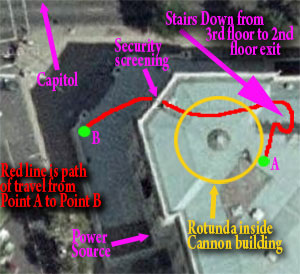 So, this is the anatomy of an assignment. Specifically, it's about how it came together, and was executed, and how, when you're a professional, with the right tools, you can make it happen, despite countless challenges. On January 16, the phone rang. It was the Art Director for a publication group that was handling a regional publication that wanted a portrait of a Member of Congress. The interview was schedule for January 24th, and the Communications Director also wanted the photography to take place that day. We discussed the details -- small circulation regional trade magazine, cover and single image inside. When asked about their budget, their figures were slightly lower than where I felt comfortable being, by about 20%. A negotiation ensued, and the result raised the figure to 10% less than I had originally proposed, and I forwarded on a contract to that effect, which was signed and returned prior to the shoot taking place.
So, this is the anatomy of an assignment. Specifically, it's about how it came together, and was executed, and how, when you're a professional, with the right tools, you can make it happen, despite countless challenges. On January 16, the phone rang. It was the Art Director for a publication group that was handling a regional publication that wanted a portrait of a Member of Congress. The interview was schedule for January 24th, and the Communications Director also wanted the photography to take place that day. We discussed the details -- small circulation regional trade magazine, cover and single image inside. When asked about their budget, their figures were slightly lower than where I felt comfortable being, by about 20%. A negotiation ensued, and the result raised the figure to 10% less than I had originally proposed, and I forwarded on a contract to that effect, which was signed and returned prior to the shoot taking place.
I then began a dialog with the Congressman's CD about timing and logistics. She proposed Thursday the 25th, and I agreed. Then she called back to say he would be out of town. No problem. How about the 24th. No, that wouldn't work, because it was the day after the State of the Union address, and he would be tired. No problem, how about the 26th. No, he would still be out of town. Then, she proposes 4pm on the 24th, and I am agreeable, and slot it into my schedule. About 30 minutes later, the phone rings, and it's the CD again. She indicates that he's getting on a flight at 4:59, so the 4pm slot won't work after all. She proposes 10am, again, the morning after a long night on Capitol Hill. I agree, and shift the schedule. (After my own coverage of the President's speech, I did not make it to sleep until 3am myself.)
We then discuss location. I propose the Cannon House Office Building terrace, right outside of the main door, and she has concerns about the cold. I suggest that it's a great angle, with nice dynamics, but I understand her concerns about the elements. I suggest the 3rd Floor balcony of the Cannon building, and she likes that idea better. I call to try to schedule a window area to accomplish the photograph in, as they are scheduled by the press gallery. I am told that CNN and Fox both have reserved the two window spaces for all morning, since they are doing reactions to the speech the night before, so I am SOL. I then ask about the inside spaces between the columns, and am told they're "first come, first served." No problem, I'll take that, since there are alternative backup locations nearby if they are all full.
I call back, and she now agrees that we can do the outside shot, weather permitting, and that the inside location is our backup location. We arrive at 9:15, to set up for what we believe will be a 10am shot. She indicates that he will be in between meetings, and that they only have enough time for one location, and when I indicate we'll be done with him in 5 or 10 minutes, maximum, she's nervous, suggesting that that much time is not available. We set up both the inside and the outside locations.
The inside location is lit with a single Hensel head, at about 1/8 power, and mixed with the ambient light from outside, giving me an exposure of f5.6 at 1/40th for ISO 500, with the camera set to the "flash" color temperature reading, a Plume 140 with the wafer in (and two stops of an ND filter inside), and a litedisc reflector. The trick was getting the head out beyond the balustrade so that the light was coming in towards the subject. Once complete, I am comfortable with all the light/f-stop settings for this look. (see wide image of the setup below).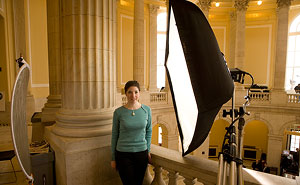
The outside location is also a single Hensel head, but at 2/3 power, with the Chimera 5 softbox. We had to run power from about 80 feet away, and it started as an overcast day, so I put a Full CTO gel into the softbox and set the camera to the "tungsten" setting so that all the ambient would go blue, and further, I stopped down a bit so it would be a bit darker. At 100 ISO, I was at f10 at 1/200th. I very much like this look and feel, and it reinforces the fact that this was the right first choice for what I was going for. (see wide image of the setup below, with a different subject stand in, and my bundled up assistant who was still cold afterwards.)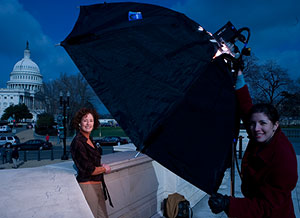
At 10:02, we learn that one of the House committees has scheduled a meeting for 10am, and that the earliest he will be available will be 11am.
At 11am, we learn that it will be atleast another 30 minutes. And, at 11:45 he arrives, at the inside (secondary) location. I've chosen to wait for him inside, since, at that moment, I am in a secure area, having already been screened by security. My assistant, who helped set up, has been outside, for 2 hours, with the equipment, in a non-secure area. All the lighting has been tested and pre-set (of course), and I make the first image at 11:45:09 (see below).
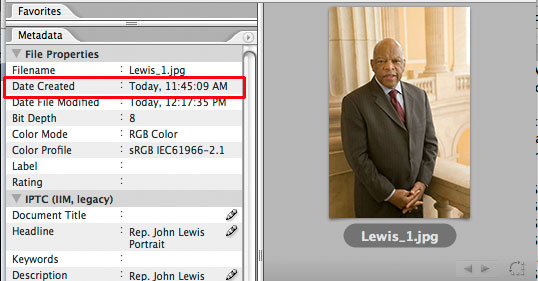 After two dozen images, both vertical and horizontal, I say to the Congressman "we've got the second setup right outside the door, where my assistant is already waiting with the lights set up." We walk downstairs, and out the door, through security. Since we are leaving, there is no delay, however, if we had started outside, I would have had to pass through the metal detectors and my camera through the x-ray machine, but the Congressman would not have, nor would he have had to wait if there was a line, I would have. Tactically, it was best to go the other direction. We get outside, and the light is different from how it was 2 hours earlier, it's sunnier, and so I make a quick adjustment to the light power, and make a test frame. Then, I continue shooting outside. After about 30 seconds I ask him how he's doing comfort-wise because there were a few intermittent snow-flakes falling, and he said he was fine. After about another dozen frames, I stop and tell him "we're done sir, thank you for your time..." and he's off to his next meeting. The final frame and revealed metadata is below.
After two dozen images, both vertical and horizontal, I say to the Congressman "we've got the second setup right outside the door, where my assistant is already waiting with the lights set up." We walk downstairs, and out the door, through security. Since we are leaving, there is no delay, however, if we had started outside, I would have had to pass through the metal detectors and my camera through the x-ray machine, but the Congressman would not have, nor would he have had to wait if there was a line, I would have. Tactically, it was best to go the other direction. We get outside, and the light is different from how it was 2 hours earlier, it's sunnier, and so I make a quick adjustment to the light power, and make a test frame. Then, I continue shooting outside. After about 30 seconds I ask him how he's doing comfort-wise because there were a few intermittent snow-flakes falling, and he said he was fine. After about another dozen frames, I stop and tell him "we're done sir, thank you for your time..." and he's off to his next meeting. The final frame and revealed metadata is below.
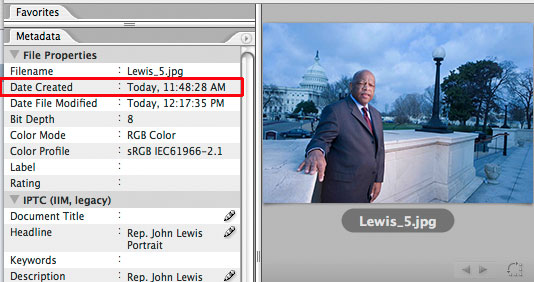
Yes, that's 3 minutes, 19 seconds. Two set ups, travel time between sets, everything. And, the client has dozens of images to choose from. In fact, with a wireless card and on-site laptop, I am able to deliver three or four low resolution selects to the client, who was a bit nervous about the shoot even coming-off at all, given all the changes to the schedule. Giving them piece of mind that not only did it happen, but we got two setups, and we are pleased with the images. Their response, via e-mail, prior to our completion of the breaking down of the equipment was "Got the e-mail and site link. i will forward over to {designer}. These are really good. well done." Yea. Happy client!
So, why do I share all of this? Because, when time mattered, when it really came down to it, the pre-setting, the pre-testing, and logistical reviews meant that the shots came off. Professional grade flash equipment, with fast recycle times and great light modifiers and stands meant that we could produce what we wanted, exactly how we wanted to. We weren't limited by a flash's power necessary to overcome the sun in an outdoor setting, especially with a 5' softbox. We had a full complement of ND filters, and CTO filters at our disposal to achieve the desired effect, since when we dialed down the inside flash pack, it was still 2 stops too bright, and required ND.
Moreover, this example reinforces the fact that we are not billing for our time, but for our expertise. For our ability to trouble shoot, see three steps ahead, and anticipate all eventualilties (or as many as possible) and plan for them. Our fees should be in direct opposition to the length of time we can work in. The faster we can accomplish a task, the more we should be paid. Yet, many clients look to determine what they will pay based upon the length of time you are working for them, as if you are a form of a day laborer, punching a clock. This incorrectly suggests that the beginning photographer, who might have taken hours to light it, and many many more minutes to make the images while the subject stands patiently by, would be paid more than someone who can accomplish the same goals within about 3 minutes. Helping a client to understand that you will deliver even when you are thrown a curve ball -- when -- literally, every second counts, means that the client is more likely to agree and pay you commensurate with that level of experience and set aside thoughts of a "half-day" or "day rate" approach. I see that conclusion as one with ensures clients see the value I bring to an assignment, beyond minutes, technical skill, and gear, and one which will ensure a long and beneficial relationship for us both.
Please post your comments by clicking the link below. If you've got questions, please pose them in our
Photo Business Forum Flickr Group Discussion Threads.
[More: Full Post and Comments]
 So, I spent all week long without the charger for my camera. Friday before last, I completed an assignment, and we (and by we, I mean myself and the first and second assistants) were flying to pack up, and in our haste (well, frankly, their haste, packing was their responsibility) the charger for my camera batteries was left behind. I did not realize this until mid-week, when I needed the charger and could not find it. I spent (and by spent, I mean, I paid the two assistants to look) two hours scouring the office and re-opening all the lighting cases looking for the wayward charger. Alas, to no avail.
So, I spent all week long without the charger for my camera. Friday before last, I completed an assignment, and we (and by we, I mean myself and the first and second assistants) were flying to pack up, and in our haste (well, frankly, their haste, packing was their responsibility) the charger for my camera batteries was left behind. I did not realize this until mid-week, when I needed the charger and could not find it. I spent (and by spent, I mean, I paid the two assistants to look) two hours scouring the office and re-opening all the lighting cases looking for the wayward charger. Alas, to no avail.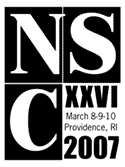 This March (March 8th, 9th, and 10th) marks my sixth time presenting at the
This March (March 8th, 9th, and 10th) marks my sixth time presenting at the 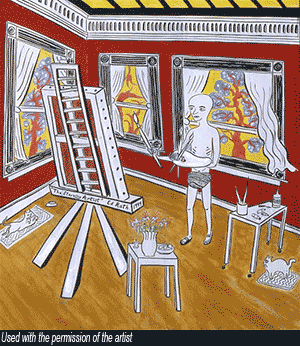
 I can remember when I started out, I ate so much Top Ramen, that I began figuring out ways to make it taste better than it did. I had cupboards full of it, when I could buy it at 10 for $1. I did this however, not because I was just trying to get by on the $25 assignments, but because, as someone just starting out, I had just a few of the $125/hr 4 hr minimum assignments each month. Yet, when you do the math, would you rather do a single assignment for $500 maybe three times a month, or 60 for $25? I submit that with 60 assignments you should be an employee of that company. At $150 an assignment (which is what a few wire services pay and expect you to live on) you'd need 10, or 2.5 a week. Either of these scenarios means that, when the calls (albiet few and far between in the beginning) come in for the $500 assignment, you will be booked doing something else and unable to take the assignment. While I have long-since graduated from Top Ramen, every so often I will pick up a pack, and in an odd way, remember the "good" old days.
I can remember when I started out, I ate so much Top Ramen, that I began figuring out ways to make it taste better than it did. I had cupboards full of it, when I could buy it at 10 for $1. I did this however, not because I was just trying to get by on the $25 assignments, but because, as someone just starting out, I had just a few of the $125/hr 4 hr minimum assignments each month. Yet, when you do the math, would you rather do a single assignment for $500 maybe three times a month, or 60 for $25? I submit that with 60 assignments you should be an employee of that company. At $150 an assignment (which is what a few wire services pay and expect you to live on) you'd need 10, or 2.5 a week. Either of these scenarios means that, when the calls (albiet few and far between in the beginning) come in for the $500 assignment, you will be booked doing something else and unable to take the assignment. While I have long-since graduated from Top Ramen, every so often I will pick up a pack, and in an odd way, remember the "good" old days. In fact, there is even a book,
In fact, there is even a book, 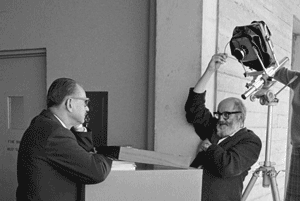
 So, this is the anatomy of an assignment. Specifically, it's about how it came together, and was executed, and how, when you're a professional, with the right tools, you can make it happen, despite countless challenges. On January 16, the phone rang. It was the Art Director for a publication group that was handling a regional publication that wanted a portrait of a Member of Congress. The interview was schedule for January 24th, and the Communications Director also wanted the photography to take place that day. We discussed the details -- small circulation regional trade magazine, cover and single image inside. When asked about their budget, their figures were slightly lower than where I felt comfortable being, by about 20%. A negotiation ensued, and the result raised the figure to 10% less than I had originally proposed, and I forwarded on a contract to that effect, which was signed and returned prior to the shoot taking place.
So, this is the anatomy of an assignment. Specifically, it's about how it came together, and was executed, and how, when you're a professional, with the right tools, you can make it happen, despite countless challenges. On January 16, the phone rang. It was the Art Director for a publication group that was handling a regional publication that wanted a portrait of a Member of Congress. The interview was schedule for January 24th, and the Communications Director also wanted the photography to take place that day. We discussed the details -- small circulation regional trade magazine, cover and single image inside. When asked about their budget, their figures were slightly lower than where I felt comfortable being, by about 20%. A negotiation ensued, and the result raised the figure to 10% less than I had originally proposed, and I forwarded on a contract to that effect, which was signed and returned prior to the shoot taking place.

 After two dozen images, both vertical and horizontal, I say to the Congressman "we've got the second setup right outside the door, where my assistant is already waiting with the lights set up." We walk downstairs, and out the door, through security. Since we are leaving, there is no delay, however, if we had started outside, I would have had to pass through the metal detectors and my camera through the x-ray machine, but the Congressman would not have, nor would he have had to wait if there was a line, I would have. Tactically, it was best to go the other direction. We get outside, and the light is different from how it was 2 hours earlier, it's sunnier, and so I make a quick adjustment to the light power, and make a test frame. Then, I continue shooting outside. After about 30 seconds I ask him how he's doing comfort-wise because there were a few intermittent snow-flakes falling, and he said he was fine. After about another dozen frames, I stop and tell him "we're done sir, thank you for your time..." and he's off to his next meeting. The final frame and revealed metadata is below.
After two dozen images, both vertical and horizontal, I say to the Congressman "we've got the second setup right outside the door, where my assistant is already waiting with the lights set up." We walk downstairs, and out the door, through security. Since we are leaving, there is no delay, however, if we had started outside, I would have had to pass through the metal detectors and my camera through the x-ray machine, but the Congressman would not have, nor would he have had to wait if there was a line, I would have. Tactically, it was best to go the other direction. We get outside, and the light is different from how it was 2 hours earlier, it's sunnier, and so I make a quick adjustment to the light power, and make a test frame. Then, I continue shooting outside. After about 30 seconds I ask him how he's doing comfort-wise because there were a few intermittent snow-flakes falling, and he said he was fine. After about another dozen frames, I stop and tell him "we're done sir, thank you for your time..." and he's off to his next meeting. The final frame and revealed metadata is below.

 Just because you THINK everyone else is signing WMFH agreements, doesn't make it the right thing to do -- i.e. to transfer your copyright. Morover, as you stay in business longer, you realize that, in fact, everyone ISN'T signing these agreements, it's photo editors telling you this (to get you to sign), or it's other defeatist photographers just giving in and signing.
Just because you THINK everyone else is signing WMFH agreements, doesn't make it the right thing to do -- i.e. to transfer your copyright. Morover, as you stay in business longer, you realize that, in fact, everyone ISN'T signing these agreements, it's photo editors telling you this (to get you to sign), or it's other defeatist photographers just giving in and signing.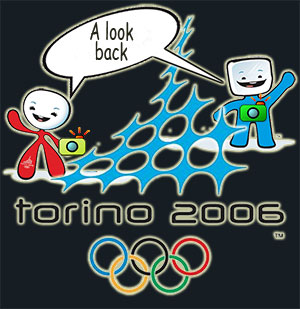 The concept -- "The Upside of Down" is simply the concept of growing through loss or challenge, and how this idea seems to be mostly devoid from many photographers approaches to their existence. It must always be roses and caviar, no burdens or challenges to tax their minds. In other words, the path of least resistance (and that usually equates to the path with the lowest pay or most onerous rights demands) is the road most taken. One of the things that always amazes me is how people in general (and photographers are not immune from this) will hold in admiration a colleague who is far more advanced in their career than they are, and how they would seem to do just about anything to spend time with them, learn from them, or possibly be mentored by them. Sometimes they write and ask for advice, othertimes, they talk during the down times of a lengthly assignment, yet, when they see the first opportunity to leap in and "replace" that photographer who's objected, in principle, to taking an assignment for a really bad deal, how they see nothing wrong with it.
The concept -- "The Upside of Down" is simply the concept of growing through loss or challenge, and how this idea seems to be mostly devoid from many photographers approaches to their existence. It must always be roses and caviar, no burdens or challenges to tax their minds. In other words, the path of least resistance (and that usually equates to the path with the lowest pay or most onerous rights demands) is the road most taken. One of the things that always amazes me is how people in general (and photographers are not immune from this) will hold in admiration a colleague who is far more advanced in their career than they are, and how they would seem to do just about anything to spend time with them, learn from them, or possibly be mentored by them. Sometimes they write and ask for advice, othertimes, they talk during the down times of a lengthly assignment, yet, when they see the first opportunity to leap in and "replace" that photographer who's objected, in principle, to taking an assignment for a really bad deal, how they see nothing wrong with it. 